
This article appeared in the Vol. 19 No. 1 / Spring-Summer 2012 issue of West 86th.
This article considers the relationship between self-conscious cultural reawakening in early Pahlavi Iran and the widespread vogue for Persian art and aesthetics in the contemporary United States. The most enduring legacy of “Persomania” in the United States is Doris Duke’s Honolulu home known as Shangri La, which underwent a process of systematic “Persianization” during the formative stage of its history, circa 1937–40. In addition to exploring the fusion between Shangri La’s modernist core and Persian architectural forms (both pre-Islamic and Islamic), this article examines the property’s collection of custom-made Isfahani tilework, which can be classified as Safavid revival and which has significant ramifications for the broader field of Persian ceramic studies.
In 1926, the gold medal for best national pavilion at Philadelphia’s Sesquicentennial International Exposition was awarded to a building inspired by the Masjid-i Shah (Shah Mosque, 1612–ca. 1630), a congregational mosque in Isfahan, Iran. Just under a decade later, the Marble Palace in Tehran (ca. 1934–37) was topped with a dome echoing that of a second Isfahani mosque, the Masjid-i Shaykh Lutfallah (Shaykh Lutfallah Mosque, 1603–19). Shortly thereafter, Doris Duke, a young American heiress in need of decoration for her Honolulu home, known as Shangri La, commissioned an Isfahani workshop to create a mosaic panel replicating one of a pair on the entrance portal of the Masjid-i Shah (fig. 1). These three examples suggest that the arts of Safavid Iran (1501–1722)—particularly those of the capital city of Isfahan—resonated on an international scale during the early twentieth century.
The central aim of this article is to trace the systematic “Persianization” of Doris Duke’s Shangri La during the late 1930s while simultaneously contextualizing this private project within global narratives of cross-cultural encounter, revivalism, and modernism.1 To date, cross-cultural exchange between early Pahlavi Iran and the United States and Europe has been primarily examined through the ephemeral spaces of museum exhibitions, the buildings of Tehran, contentious archaeological projects, and such male personalities as Arthur Upham Pope. By ultimately focusing on the Shangri La case study, I expand the lens of inquiry beyond the immediate Iranian context, examine an understudied period and medium of artistic production (early Pahlavi tilework), and introduce lesser-known figures in the history of Persian art history.
Revivalism and Preservation in Early Pahlavi Iran
In the years immediately prior to Riza Shah Pahlavi’s (r. 1925–41) accession to the throne of Iran, a spirit of national pride rooted in cultural hegemony, and largely stimulated by archaeological discovery, permeated the upper levels of Persian society. As elsewhere in the Middle East, this self-conscious cultural reawakening coincided with an impetus toward preservation.2 In 1921, the Society for National Heritage (SNH) was created “to preserve, protect, and promote Iran’s patrimony.”3 The following year, its bylaws stipulated that “the purpose of the SNH is to cultivate public fascination with Iranian scientific (elmi) and industrial (san‘ati) historic heritage (asar-e tarikhi) and to attempt to protect the fine arts (sanaye-e mostazrafeh) and handicrafts (sanaye-e dasti) and to preserve their old style and method.”4 As early as 1922, then, Iranians themselves had established a dichotomy between handicrafts and fine arts. While the former were identified with such techniques as tile mosaic and woodwork, the latter were associated with the western traditions of oil painting and sculpture.
The SNH’s call for historic revivalism soon found an outspoken advocate in an American art historian, Arthur Upham Pope (1881–1969). In a well-known speech delivered in 1925 to various Iranian dignitaries, including Riza Khan (soon to be crowned Riza Shah), Pope praised Iran’s Achaemenid (559–331 BCE), Sasanian (224–651 CE), and Safavid (1501–1722 CE) histories while simultaneously urging the government to abandon European prototypes, to establish schools and museums devoted to the arts of Persia’s past, and to support an export trade of “modern crafts,” all of which would ensure the preservation of “ancient craft.”5 Pope was particularly effusive about the technique of “mosaic faience” (tile mosaic), which he associated with Safavid Isfahan: “Lavishly decorated architecture sprang up in many places, the best examples of which are to be seen at Isfahan, with their superb ornamentation of mosaic faience…There are splendid craftsmen still at work in Persia. The precious mosaic faience, which was thought to be a lost art, is still made almost as perfectly as in the classical days.”6 Although Pope was in many ways preaching to the choir, the Pahlavi government was unwilling to entirely abandon European models, especially the International Style of architecture, one component of which had its roots in the anti-ornament theories of Adolf Loos (1870–1933).7 Whereas Loos perpetuated a rigid distinction between functionality and ornament, the Pahlavi regime and its architects actively sought the mediation of the two. Ultimately, the “functionalism” of the International Style and the ornament of Iran’s cultural heritage were reconciled in a discourse known as Neo-Achaemenid or Neo-Sasanian, depending on the pre-Islamic past in question.8 An example of the former was Tehran’s National Bank (1935), designed by the German architect H. Heinrich.9 To enliven the modernist structure, columns and reliefs inspired by those at Persepolis, the Achaemenid capital concurrently being excavated by the Oriental Institute of the University of Chicago, were inserted on to its facade. Upon completion, the National Bank underscored the Pahlavi regime’s cultural self-consciousness while simultaneously conveying its modernist inclinations.
While scholarship to date has mostly examined the revival of Iran’s pre-Islamic past during the early Pahlavi period, it is equally important to consider simultaneous efforts devoted to the Islamic heritage, particularly that of Safavid Isfahan (1598–1722). According to several witnesses, Pope’s effusive praise of Isfahan during his 1925 speech and his lament about missing tiles on the Masjid-i Shaykh Lutfallah made a deep impact on Riza Shah, who soon called for the mosque’s restoration.10 Approximately a decade later, the dome of the mosque served as the prototype for that of the Shah’s Marble Palace in Tehran, which was designed in part by Pope.11 The interior of the palace was also decorated with examples of Safavid revivalist “craft” based on Isfahani models.12
Concurrent with the construction of the Marble Palace in Tehran was the systematic restoration of the Safavid monuments of Isfahan.13 One of the most useful sources for reconstructing these efforts is a Persian text entitled Salnamah-i Ma‘arif-i Isfahan Sal-i Tahsili, 1313–1314 (Report of the Isfahan Ministry of Education, Academic Year 1934–36). This report includes a chapter entitled “Restoration of Historical Monuments of Isfahan,” with sections devoted to the Masjid-i Shah, Masjid-i Shaykh Lutfallah, and the Madrasa Chahar Bagh (College of the Four Gardens, 1706–14), respectively.14 Among numerous details, it names the individuals responsible for the restorations (religious authorities, city officials, ceramists), records the amount of money spent on each project, and describes repairs to specific components of each building (iwans, domes, courtyards, tilework). Above all, this text underscores the Ministry of Education’s conservative approach to restoration (“no alteration would be made to the original thing”).15 The Salnamah also includes photographs of the monuments in question, most of which are identified as having been shot before, during, or after restoration.
In 1931, Pope published an essay on tile mosaic, which included photographs of ceramists at work on the restoration of the dome of the Madrasa Chahar Bagh.16 Pope’s intentions in this essay were twofold: to educate readers about the technique of tile mosaic and to emphasize that it “was actually being quietly practiced in both Mashad [Mashhad] and Isfahan with a skill that lacked little if anything of that of earlier days.”17 The latter assertion echoed comparable comments in his 1925 speech, confirming his participation in the calculated marketing of Iran’s “modern crafts.”
The most systematic American documentation of Isfahan’s restoration projects was collected by Myron Bement Smith (1897–1970), one of Pope’s colleagues in the American Institute for Persian Art and Archaeology.18 Between 1935 and 1937, Smith photographed all of the monuments considered in the Salnamah. He subsequently adhered his prints to large index cards and recorded on the verso of each the name of the building, its location, and the date of his photograph. Given the excellent condition of Smith’s original photographs, which are preserved in the Freer Gallery of Art and Arthur M. Sackler Gallery Archives, all references herein are to them, rather than to the comparable examples reproduced in the Salnamah.19
Both the Salnamah and Smith’s photographs confirm that repairs to the Madrasa Chahar Bagh continued well into the mid-1930s. A Smith photograph dated to August 1935 depicts a resplendently restored dome, a drum intact except for the upper inscription, a damaged minaret in the background, and a minaret covered in scaffolding in the foreground (fig. 2).20
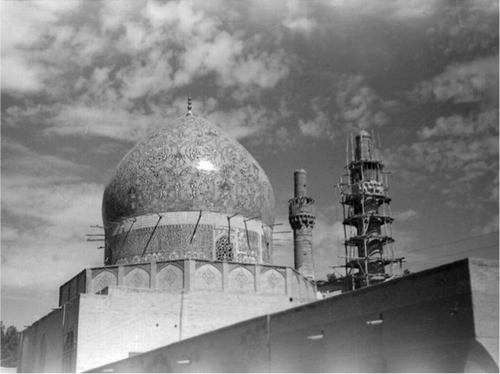
A second photograph, which is not dated but which must have been shot after the August 1935 image, depicts the foreground minaret after its restoration.21 In some instances, Smith credited the ceramists in charge of these repairs. A photograph dated July 7, 1935, shows a ceramist standing next to a large grill on the drum of the dome (fig. 3). Smith’s handwritten caption on the reverse notes, “Shown is the tile cutter and mason responsible for the current repairs: Ustad Hadjdji Husain.”
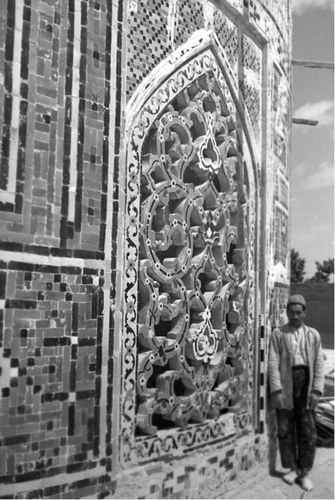
According to the Salnamah, repairs on the dome of the Masjid-i Shaykh Lutfallah commenced in September 1935 (Shahrivar 1314) and were completed in June 1936 (Khurdad 1315).22 A rather ominous Smith photograph dated January 12, 1936, captures the exterior of the dome covered in scaffolding, while a second example shot from above within the interior shows tiles being assembled facedown on the dome template (fig. 4).23
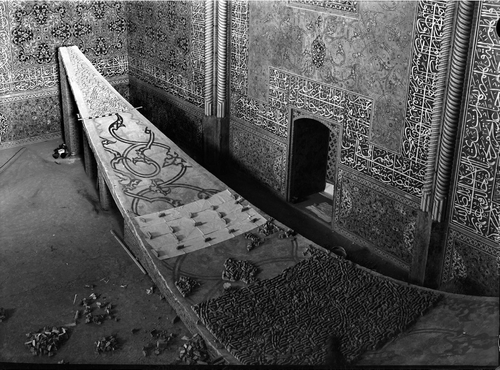
From the contemporary Salnamah, we can further appreciate the complexity and success of these repairs:
The point that it is necessary to remember is that of the sixteen sections of the dome (gunbad), each of which is 23 meters long, nearly two-thirds, the tiles of the upper part, were broken or shattered, and that one-third, the lower part, which had been less exposed to external elements, was intact. Moreover, what adds to the importance of the repair (ta‘mir) of the dome is the care (diqqat) taken in the repair of the upper portion, for in the end, after the repairs were complete, one could in no way tell the difference between the old (qadim) and the new (jadid) parts. The artists (ustadan), who worked only with total heart and modest expectation on this task—because this is a religious and national monument—need to be appreciated. They are Ustad Ghaffar, tilemaker (kashi tarash), and Ustad Nasrallah, painter and plaster molder (naqqash va gachbur).24
As documented in the Salnamah, the most pressing concern at the Masjid-i Shah during the mid-1930s was a large crack that had formed on the southwest iwan (barrel vault) leading into the domed sanctuary. Smith’s photographs, shot between January 1936 and February 1937, also reveal considerable dilapidation to the tilework sheathing other iwans, as well as the dome and minarets.25 By mid-1937, however, the tiled surfaces of Isfahan’s three main Safavid religious monuments—Madrasa Chahar Bagh, Masjid-i Shaykh Lutfallah, and Masjid-i Shah—had been restored to their former resplendence. This physical revitalization of “half the world” (nisf-i jahan, as Isfahan was known) coincided with the city’s burgeoning reputation in the United States and Europe, and it is to these contexts that I now turn.
“Persomania” on the Global Stage26
During the late nineteenth century, Americans primarily identified the Islamic “Orient” with the Levant and North Africa.27 Fascination with Iran no doubt existed, however, as evinced by Frederick Edwin Church’s (1826–1900) identification of “Persia” as the primary inspiration for his Hudson River home, Olana, even though he never traveled to Iran and hence had to “imagine Persian architecture.”28 During the mid-1920s and 1930s, popular imagination was increasingly supplemented by tangible works of art and documentation, as Pope resolved “to carry the news of these Persian treasures to as many people as possible.”29 Through his globe-trotting purveying efforts, American and European audiences were afforded an unprecedented view of Persian art, albeit an often reductive and dissonant one.30
Just a year after his “debut” on Iranian soil in 1925, Pope organized the First International Congress for Persian Art and Archaeology, which was held in conjunction with the Sesquicentennial International Exposition in Philadelphia and an exhibition of Persian art in the Pennsylvania Museum. For the former, Pope and the Philadelphia architect Carl Ziegler (1878–1952) oversaw the construction of a pavilion inspired by Isfahan’s Masjid-i Shah.31 While this re-creation successfully evoked the Safavid mosque, it was essentially an eclectic and ahistorical mélange that blended Safavid, Achaemenid, and Sasanian forms. A Persepolis-like column was erected next to it, and a Sasanian-style relief graced its side.32
A few years after the exposition, Riza Shah granted Pope permission to systematically photograph the Masjid-i Shah. Over a two-month period in 1929, the American shot nearly three hundred negatives of the structure, thereby commencing a comprehensive photographic survey of Iran’s historic monuments.33 The first Architectural Survey (1929–31) focused primarily on Isfahan, and it was not long before Pope’s trail-blazing photographs, which he regularly touted as such, adorned the walls of museums from New York to Leningrad.34 For the first time, an international public was offered a detailed view of the monuments of Safavid Isfahan, including the Masjid-i Shah and its tile revetment.
The most important event related to Persian art during the period in question was the International Exhibition of Persian Art, which was spearheaded by Pope and held at the Burlington House Fine Arts Club in London in 1931. Since this exhibition has garnered considerable scholarly attention, it suffices here to reiterate that it emphasized the “glitter” and “spectacle” of Persian art at the expense of its historical context.35 In other words, it amounted to another ahistorical mélange that, to some extent, echoed the 1926 Philadelphia pavilion.36
An even more explicit connection can be drawn between 1926 Philadelphia and 1931 London. In the latter city, Pope again sought to re-create the Masjid-i Shah in three-dimensional form. In this instance, he commissioned Isfahani workshops to create a one-third-scale model of the mosque’s entrance portal, which led into a “tiled room” filled with mosaic panels and textiles.37 Taken together, Pope’s 1926 and 1931 reinventions offered what a two-dimensional photograph could not—size, spectacle, and a World’s Fair–like experience. They also established an important precedent for the creative reinvention of Safavid forms on foreign soil while contributing to the growing public appreciation of tile mosaic. In addition to the Masjid-i Shah model and the tiled room behind it, the 1931 exhibition also included the mid-fourteenth-century Madrasa Imami mihrab, a masterpiece of mosaic that would soon be purchased by the Metropolitan Museum of Art.38
While Londoners enjoyed Persian art at first hand, several American exhibitions explored the relationship between what were broadly termed “Persian” and “Modern” art. In 1931, for example, the Brooklyn Museum of Art organized a pair of tandem exhibitions that displayed “Persian” art in conjunction with “American fabrics based on Persian design…with a cubicle containing colored drawings made by New York and Philadelphia students who have used Persian sources for their inspiration.”39 The following year, the American Institute for Persian Art and Archaeology—specifically, Pope, with the assistance of Smith—launched the exhibition Persian Fresco Paintings, which was a resounding success at New York’s Museum of Modern Art (MoMA).40 The show centered on Sarkis Katchadourian’s “reconstructions” of Safavid murals located in a private home in New Julfa, the Armenian suburb of Isfahan, and two of the city’s Safavid pavilions, the Chihil Sutun (Forty Columns, ca. 1647–50) and the Ali Qapu (High Gate, 1590–1643). This particular instance of Safavid revival was motivated by the desire to faithfully copy the prototype and was hence greatly admired by Pope, who viewed Persian art as quintessentially “pure” and “modern.”41 He underscored this sentiment in his opening lines in the catalogue: “These reconstructions…must be welcomed as an unexpected ally that comes from a distant land to affirm the same ideal [as modernism] and demonstrate the possibility of its realization.”42
Popular journals and newspapers of the day reveal that American interest in Persian art reached a zenith in 1934, the year of the millenary celebration of the birth of Firdausi (ca. 940–1020), the author of Iran’s national epic, the Shahnamah.43 Between October 1933 and November 1934, New York alone hosted a staggering nine exhibitions devoted to Persian art and culture.44 This public, museum-based phenomenon coincided with the Persianization of private spaces throughout elite America. In 1927, for example, John S. Drum, president of the American Trust Company, commissioned Pope to design his three-bedroom penthouse suite in San Francisco’s Fairmont Hotel. Not surprisingly, Pope chose a “Persian court” style for the commission, and the penthouse’s “Game Room” was decorated with tiles, arched doorways, an octagonal fountain, hanging lamps, low sofas, and even a dome.45
At the same time, the dining room of the Royal Hawaiian Hotel in Honolulu was also decorated in a mode described as “Persian.” The hotel’s opening in 1927 was hailed as the “greatest social event” of the season, and according to the Honolulu Advertiser, the elite occasion was “New York, Hollywood, Paris, Berlin, in fact the ultra-everything in its line.”46 Similarly, in April 1934, the Plaza Hotel in New York inaugurated its self-described “Persian Room,” which was designed by Joseph Urban, stage designer of the Ziegfeld Follies, and featured five mural paintings inspired by Persian miniatures by the American artist Lillian Gaertner Palmedo.47 As recorded in the social column of the New York Times, the Plaza’s Persian Room soon became a preferred setting for exclusive debutante receptions and presentations to society.48
These three hotel interiors, dated between 1927 and 1934, underscore the desire of affluent Americans to be surrounded by what were generically identified as “Persian” aesthetics. This popular conception of the “Persian” was mainly limited to the tiles, textiles, miniatures, domes, and arches of Iran’s Islamic heritage, particularly their floral and geometric decoration. Iran’s pre-Islamic heritage, which was resonating throughout Tehran in its various “Neo” incarnations, appeared ill suited to the private tastes of elite Americans. Or so it seemed.
The Neo-Achaemenid and the Safavid Talar at Shangri La
The early twentieth-century interiors of the Fairmont, the Royal Hawaiian, and the Plaza have long been transformed and forgotten. Similarly, Pope’s eclectic reinventions of the Masjid-i Shah in 1926 and 1931 can be studied only from photographs. In contrast, Shangri La, the Honolulu home of Doris Duke (1913–93), remains an enduring legacy of the political, aesthetic, and social contexts outlined above (fig. 5). Between 1937 and 1940, when Duke was a newlywed in her mid-twenties, she oversaw the methodical Persianization of Shangri La. This process was deeply informed by the restoration and reinvention of Achaemenid and Safavid monuments in Iran, as well as the widespread vogue for all things “Persian” in the United States and Europe.
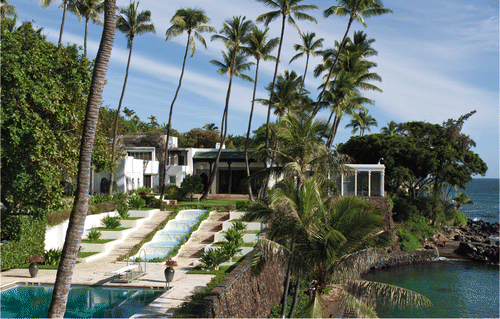
Doris Duke’s formative years were spent within the elite circles that embraced Persomania. She was a member of the crème de la crème of American society, those who convened in spaces like the Plaza Hotel’s Persian Room, and she may have visited the momentous Burlington House exhibition in 1931.49 Four years later, she married James Cromwell, stepson of the prominent investment banker Edward T. Stotesbury, and the couple immediately embarked on an around-the-world honeymoon tour.50 While in India, Duke became enamored of the Taj Mahal (completed in 1643), and the couple soon commissioned C. G. & F. B. Blomfield, a British architectural firm based in Delhi, to design and oversee the creation of a Mughal-inspired marble bedroom and bathroom suite.51 At the time, the suite was intended for Malmaison, James Cromwell’s lakefront house on the grounds of El Mirasol, the Stotesbury mansion in Palm Beach. The plan to live in Florida was abandoned shortly after the couple arrived in Honolulu, the final stop of their honeymoon tour, where Duke fell in love with the people, the solitude, and the surf. In April 1936, the Cromwells purchased a 4.9-acre lot on Oahu’s southern coast, and the Mughal suite subsequently became one of the central features of Shangri La.
Although the Cromwells’ initial interest in Islamic art was inspired by Mughal architecture, particularly that of the reign of Shah Jahan (r. 1627–58), Safavid Iran soon influenced much of their taste. The most compelling evidence for this assertion is a drawing of the living room, dated January 15, 1937, and signed by Shangri La’s on-site architectural supervisor, H. Drewry (Drew) Baker (fig. 6).52 In this drawing, a large mural of Isfahan’s renowned square, the Maydan-i Naqsh-i Jahan (Image of the World Square), decorates the room’s north wall.53 The mural itself depicts two of the square’s four main monuments: the aforementioned Masjid-i Shah and the Ali Qapu.
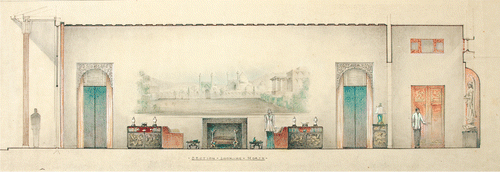
In March 1937, two months after the creation of the drawing described above, construction of Shangri La began under the supervision of the Palm Beach–based architect Marion Sims Wyeth (1889–1982), who specialized in a Spanish-Mediterranean style.54Today, much of Shangri La’s architecture is obscured by surface ornamentation and dense foliage. Archival photographs dating to the construction period reveal, however, that its architectural core is an assemblage of simple modular units with thick concrete walls. The sober trends of the International Style, which had left its mark from Ankara to Tehran, had not passed by 1930s Honolulu. Indeed, Shangri La has been compared to Mies van der Rohe’s Tugendhat House (1928–30) and Frank Lloyd Wright’s Fallingwater (1935–39).55
By the end of 1937, the basic architectural shell of Shangri La—including the main house on the east and the so-called Playhouse on the west—was complete. The Playhouse was originally conceived by the Cromwells as “a sort of combination guest-house and boat-house Cabana arrangement.”56This generic “Cabana” premise soon morphed into an architecturally specific one; the Playhouse’s facade would echo the wooden-pillared porch (talar) of the Chihil Sutun, the Safavid Isfahani pavilion whose wall paintings (or at least contemporary “reconstructions” of them) had been immortalized in the MoMA exhibition of a few years earlier.57
At some point in 1937, presumably while the Playhouse/Chihil Sutun relationship was being conceptualized, the Cromwells resolved to visit Iran in order to document architectural prototypes for refashioning Shangri La. This trip was organized by Pope, who planned everything from transportation to sustenance to permits.58 He also arranged for Mary Crane, a graduate student at New York University and a field assistant on several of the Institute’s architectural surveys, to accompany the Cromwells.59 The Iran trip lasted nearly four weeks (March 20–April 14, 1938) and included visits to Persepolis, Shiraz, Isfahan (twice), Tehran, Mashhad, Tabriz, and Pahlavi (modern-day Anzali).
Pope seems to have been quite invested in the Shangri La project and was especially anxious about how the Cromwells intended to integrate Persian architectural forms into the estate’s modernist core. Just a month before the Iran trip, he wrote to the Cromwells’ representative:
This is the first considered effort to reproduce a house that shall embody something of the Persian mode…Persian architectural ornament can be successfully adapted to a modern residence, but not if the problem is under-estimated…The success of such a house will have a real influence on the future trends of architecture in America. Many people are tired of the conventional styles. They are bored with the emptinesses, violences and pretentiousness of some of the new architecture, yet they feel the necessity for something fresh and interesting.60
Pope clearly elevated Shangri La over comparable projects, such as the Drum penthouse of 1927, and proceeded to suggest that the Cromwells hire one of his male colleagues to assist them.61 He maintained that “the most brilliant architect cannot manage the assimilation of Persian ornamental details…It can only be done by someone who has studied the architecture on the spot.”62 The Cromwells ultimately preferred the services of Mary Crane and Drew Baker, as well as their own “on the spot” training. Pope’s subsequent participation in the Shangri La project was limited and indirect, albeit at times significant, as will be shown.
Throughout the Iran trip, James Cromwell took the lead in documenting architectural prototypes. His photographic and film archive is exceptional in its quality and detail and occurred in the wake of the Institute’s first Architectural Survey, during which time many of Iran’s religious monuments were exposed to the western lens for the first time.63 In addition to clarifying Shangri La’s specific Achaemenid (Persepolis) and Safavid (Masjid-i Shah, Madrasa Chahar Bagh, Ali Qapu, Chihil Sutun) models, the Iran documentation confirms the Cromwells’ active and firsthand participation in their home’s Persianization.64 Unlike Church, they did not need to “imagine.”
In the months immediately after the Iran trip (May–September 1938), James Cromwell provided photographs and sketches of Persian prototypes to Shangri La’s architects, who used them to graft Achaemenid and Safavid forms—cornices, columns, awnings, architraves—onto Shangri La’s modernist core. In May 1938, for example, James Cromwell wrote to Drew Baker, “I am sending some pictures of the ruins at Persepolis…the columns and window and doorway designs in these pictures may give you some ideas.”65 The area in question was the ocean-facing (makai) facade of the living room, punctuated at the time by four gaping holes. Cromwell encouraged Baker to “try a sketch with the arch recessed in plain oblong Achaemenian style as per my rough sketch enclosed,” which was probably similar to a blueprint that Pope had designed and provided.66 The final aesthetic, completed in July 1938, closely paralleled Neo-Achaemenid facades throughout Tehran, particularly that of an administrative building in the heart of the city (fig. 7).67 Shangri La thus offers a rare and concrete example of Neo-Achaemenid architecture exported abroad.
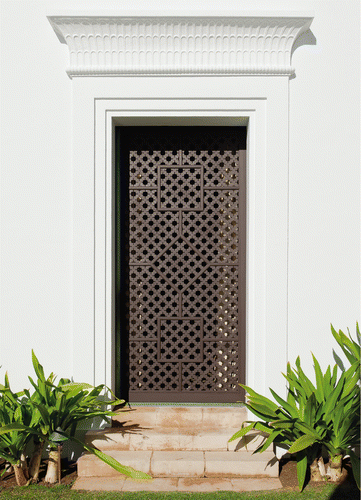
The living room’s makai facade is not the only space at Shangri La modeled after Achaemenid forms. The stairway leading to the rear entrance of the “Mughal Garden” was inspired by the Grand Stairway at Persepolis, and the lanai of the dining room features a Persepolis-style cornice and columns (minus the bull-headed capitals). Between June and September 1938, Crane and Duke exchanged a number of letters about the dining room’s exterior. In one, Crane included three pages of detailed information about the appearance of columns in the talar-front palaces of Safavid Isfahan. In a distinctly “Popian” manner, she concluded, “The more I ponder it, the less I see how you can use a modern façade on your dining-room. The forms of these Persian things are so modern in feeling that they should be easy to adapt to your dining-room interior, and surely they are as slender and as stylized as any modern column-solution would be on that façade.”68 By the fall of 1938, the Cromwells had gravitated away from a Safavid talar model for the dining room and had opted for one of its “ancient guises,” the pillared-hall of Persepolis.69 We can presume that the Achaemenid aesthetic was preferred because it was visually consistent with the adjacent living room facade (see fig. 7).
While Achaemenid forms were selected for the dining room’s exterior and the living room’s makai facade, Safavid talar prototypes were concurrently refashioned in three other spaces at Shangri La. The most obvious talar-inspired structure is the Playhouse on the far west axis (fig. 8), which had been largely built prior to the Iran trip.
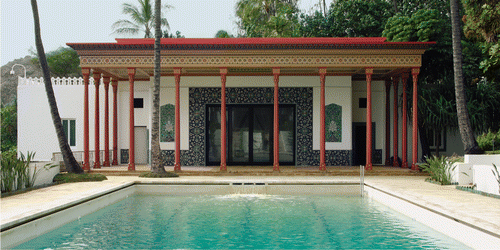
A few months after the trip, James Cromwell—now well informed and well equipped—provided Baker with his detailed photographs of the brightly painted cornice and ceiling coffers of the Chihil Sutun’s talar (fig. 9).70
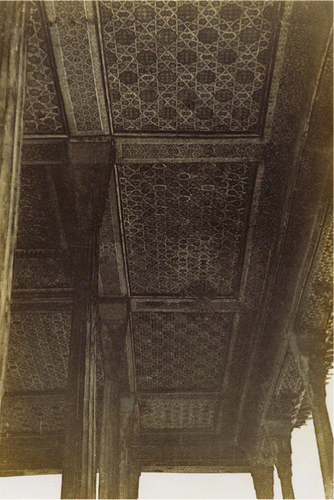
These prints soon guided the painting of the Playhouse’s lanai (cornice and ceiling), and the once generic “Cabana” was henceforth perceived by Duke herself as a “reduced version” of the Chihil Sutun (fig. 10).71
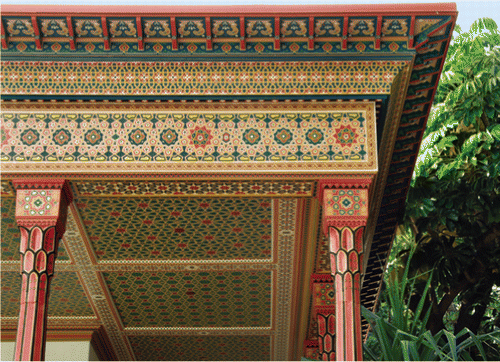
Like the Playhouse, Shangri La’s central courtyard and living room portico were also inspired by Safavid talar prototypes. The awning and columns in the courtyard were modeled after the talar of the Ali Qapu, the Safavid pavilion overlooking Isfahan’s square, which had also been a focus of James Cromwell’s documentary lenses (figs. 11–12; also see fig. 6).72
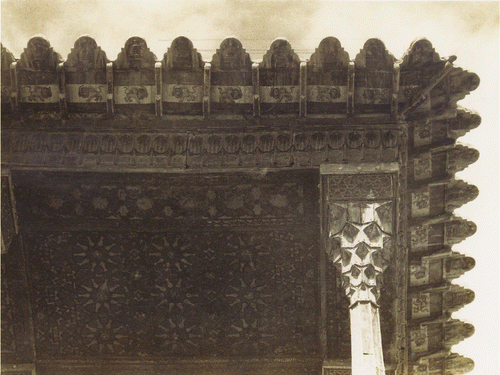
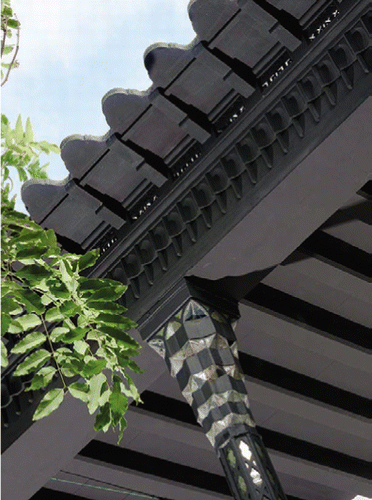
For the adjacent living room portico, the Shangri La team turned to the birthplace of talar architecture, the Caspian Sea region of Mazandaran, which the Cromwells had also visited in 1938.73 Two months after this trip, Crane sent the Cromwells an unpublished drawing of the cornice of the Imamzadah Ibrahim, a shrine located in the village of Babolsar.74 Shortly thereafter, the innermost brackets of the Imamzadah Ibrahim’s cornice were replicated as the awning of the living room portico (fig. 13).
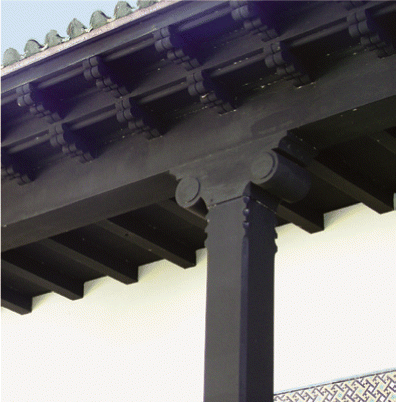
For the column capitals below, the Shangri La team selected a design associated with the northwestern city of Sardasht which they had borrowed from Ernst Herzfeld’s Am Tor von Asien of 1920.75
Considered together, the dining room lanai, the living room portico, the Playhouse, and the courtyard reflect a broad appreciation of Persian pillared architecture, from the “ancient guises” of Persepolis to the Mazandaran talar vernacular to the subsequent “alien” expressions in imperial Isfahan.76 While the Honolulu reinventions can never be confused with their original prototypes, we can appreciate the Shangri La team’s identification of Iran’s pillared architecture as an ideal complement to the Hawaiian tradition of lanai architecture, their consideration of both vernacular and imperial talar traditions, and their resourceful use of their own “on the spot” training. Equally compelling is the Neo-Achaemenid facade of the living room and its parallels with contemporary Tehrani ones. The final effect of strolling through Persianate Shangri La is one of historical dissonance—Achaemenid, Safavid, Neo-Achaemenid—yet formal harmony with the modernist building and Hawaiian landscape.
Shangri La’s 1938 Tile Commissions
Shangri La’s two-dimensional tile revetment—the second major outcome of the 1938 Iran trip (the first being the architectural re-creations described above) and the final stage of Shangri La’s Persianization—did not materialize at the property until the summer of 1940. In advance of the Cromwells’ trip, Pope arranged for them to meet Ayoub Rabenou, an Iranian art dealer based in Paris and Tehran. In January 1938, Pope and his wife, Phyllis Ackerman (1893–1977)—the couple self-identified as “Ackerpope”—sent the following cablegram to Rabenou in Paris:
very wealthy important orient building house Persian style much interested mihrab both spandrels total business should be large…also going Persia will buy many antiques and modern things.77
That same day, “Ackerpope” also sent the following cablegram to Husayn Ala, the Iranian ambassador to the United States:
Mr. and Mrs. James Cromwell members Institute visiting Iran short notice primarily for information and purchase materials for important residence in Iranian style [stop] exceptional opportunity make favorably known modern crafts especially all kinds tile and modern woven fabrics copying antiques [stop] certain to have favorable influence on subsequent export trade to America [stop] hope you can arrange every facility…visit offers valuable opportunity Iran.78
Since the Cromwells were interested in both the “antiques” of the Persian past and the “modern things” of the Pahlavi present, Pope clearly identified them as the ideal foreign clients to stimulate Iran’s export trade of “modern crafts.”
As Pope anticipated, the Cromwells purchased large quantities of both “antique” and “modern” tilework from and through Rabenou to sheath Shangri La’s sober modernist facades. The majority of the historic tilework was acquired during the couple’s visit to Isfahan in April of 1938.79 At the same time, the Cromwells drafted a contract with Rabenou stipulating that he would oversee an Isfahani workshop’s creation of custom-made tilework based on photographs of Safavid prototypes.80 These commissions were ordered in both mosaic and underglaze for the following spaces at Shangri La: the courtyard (chimney facing, patio stair facing, spandrels, grills, borders), the facade of the Playhouse (window surround, rectangular panels, borders), the interior of the Playhouse (spandrels), and the facade of the living room portico (window surround, spandrel, borders).81 With the exception of the last space, the living room portico, all of this tilework was inspired by the recently restored surfaces of the Masjid-i Shah.82 The conception, production, and installation of the tile commissions occupied two years (April 1938–October 1940).
The two most important and complex commissions were ordered in mosaic for the courtyard: the “Chimney” and “Patio Stair Facing” panels. The nearly twenty-foot-tall “Chimney” panel (DDFIA 48.93, see fig. 1) is located on the south wall of the courtyard and was inspired by one of a pair of similarly sized panels on the entrance portal of the Masjid-i Shah (fig. 14).
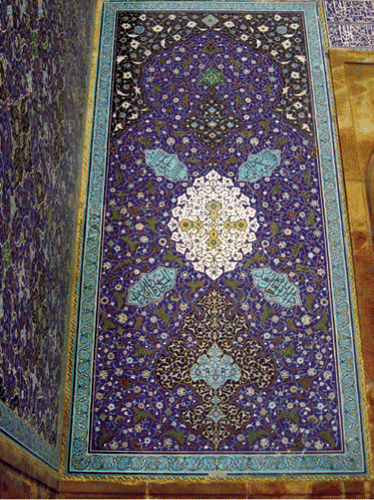
Although this panel is Shangri La’s most faithful imitation of a Safavid prototype, it lacks approximately two feet of the original’s lower edge, and its glazes are noticeably different (fig. 15).
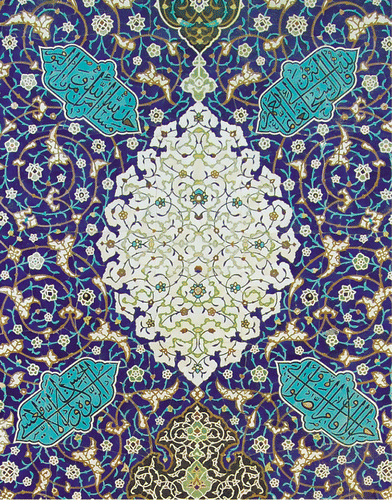
Besides an abundance of white, the commission’s hallmark glaze is a pinkish-red copper luster, the product of a dual firing process.83 The green and black glazes are also distinct, being bright green rather than dark green, and uniformly black rather than black modulating into eggplant. These differences acknowledged, the commission is commendable, and considerable effort was made to replicate the original’s Qur’anic inscriptions (9:18) and the sizes and shapes of the individual pieces of tile.
Like the courtyard panel, the “Patio Stair Facing” (DDFIA 48.407)—the second of the two major commissions—was also inspired by tilework on the Masjid-i Shah’s entrance portal (fig. 16).

Unlike the former, it is best described as a creative amalgam of several small panels, rather than a replica of a single large one. During the March–April 1938 trip, James Cromwell took at least six photographs of the two-dimensional panels forming the base of the entrance’s extensive muqarnas (stalactite formation).84 “Enlargements” were then made from “Jim’s slides,” and preferred panels and borders were numbered (one through nine) (fig. 17).85 By September, Baker had created a “template” specifying how the panels numbered on the “enlargements” were to be assembled to form the “Patio Stair Facing.”86.
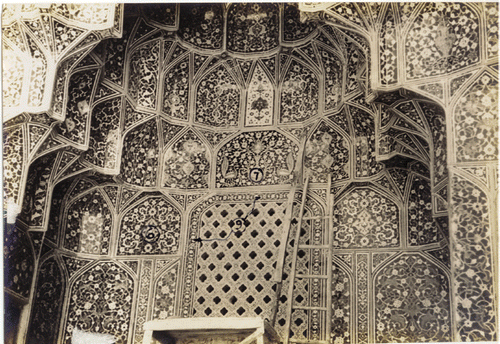
Ultimately, the custom-made panels retained sizes and functions comparable to those in the original context.87 Given the popularity of the Masjid-i Shah in Iran and abroad during the early twentieth century, its resonance at Shangri La in 1938 is perfectly understandable (fig. 18).
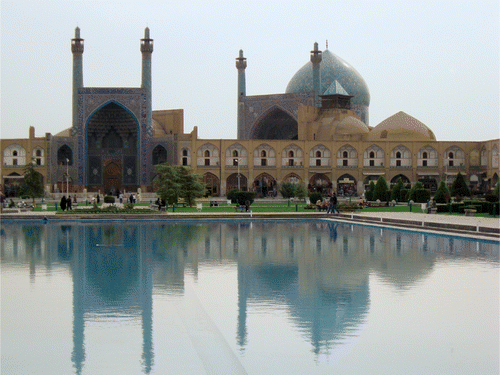
In addition to being restored during the mid-1930s, it had also been reinvented in three-dimensional form in Philadelphia and London, and its tiled surfaces had been highlighted in Pope’s photography exhibitions.88 We can thus position Shangri La’s tile commissions as an expression of global interest in the Masjid-i Shah, rather than the result of an isolated Orientalist whim. It may be further appropriate to locate their agency less with the Shangri La team and more with a predominantly Iran-based network, including members of the Society for National Heritage and Rabenou. During the 1938 visit, the Cromwells were likely steered in the direction of the newly restored mosque and given the “choice” to document their favorite design prototypes. Their detailed documentation would have been approved in advance by local authorities, as will be further elucidated below.
More information about the tile commissions can be gleaned from a group of seven photographs of the Isfahani ceramists at work on the order, all of which were shot on March 20, 1939, and include inscriptions by Rabenou on their versos.89Some of the photographs are Orientalist clichés, others are more neutral “progress reports” for the patrons, and still others are a combination of both modes (fig. 19).
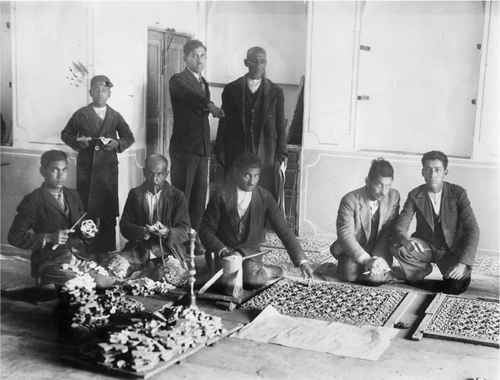
Perhaps the most compelling is a group portrait of Rabenou surrounded by approximately two dozen craftsmen ranging from school-age apprentices to elderly masters (fig. 20).
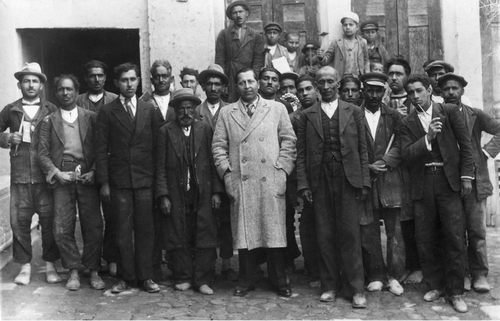
From Rabenou’s inscription on the reverse of a separate photograph, we learn that the elderly man to his immediate right is Ustad Muhammad, “le grand spécialiste fabriquant des tiles” (the master tilemaker), while the taller man to his left is “le grand maître spécialiste de mosaïque faience” (the master of tile mosaic).
Additional information about the Isfahani workshop has recently come to light with the discovery of a film documenting the creation of the courtyard panel (see fig. 1). This film, entitled The Art of Persia, was “directed, photographed and narrated” by Stephen H. Nyman, who served as a technical assistant for the American Institute for Persian Art and Archaeology during the mid to late 1930s.90 Under the auspices of the Institute, Nyman created four films about early Pahlavi Iran, all informed by Pope’s vision of Persian art.91 In 1939, Nyman published a short article about his experiences “filming in the New Iran” in which he praised Riza Shah’s modernization efforts while also underscoring the regime’s censorship of his work: “Those photographing in Persia with motion picture cameras must now be accompanied by an officer who sees that they do not ignore amenities and the regulations. If the photographs are taken without such supervision…then the finished product must be reviewed.”92
The Art of Persia considers four types of Persian art: miniature painting, tile mosaic, inlaid wood, and printed cotton textiles. In the middle of the section devoted to mosaic, Nyman’s camera transitions to a large panel being composed on the floor of a room. About it Nyman says, “This one, consisting of about 17,000 pieces, was being made for Doris Duke Cromwell’s Hawaiian palace.”93 Two individuals are shown arranging the mosaic fragments facedown; one may be the tall “master of tile mosaic” in Rabenou’s photographs; the other may be the dealer himself. The film proceeds to record how cardboard was used to divide the panel into smaller sections, and “bits of rope” were then placed on top of the fragments to “give greater strength to the backing of the tile” before it was covered in plaster.94
Being able to highlight the name of a wealthy American patron—“Doris Duke Cromwell”—in The Art of Persia must have been an advertising coup for proponents of Iran’s “modern crafts” export industry. Both Americans and Iranians were behind this strategic marketing. Although the film was produced by an American team, the opening frame acknowledges Husayn Ala—the Iranian diplomat, member of the Society for National Heritage, and close ally of Pope’s—and either he or one of his colleagues would probably have provided the final stamp of approval. Through Nyman’s film, the regime had found a way to preserve and extol “ancient craft”—albeit largely for commercial purposes—while juxtaposing it in relation to concurrent advancements in “fine art.” The film’s section on painting, for example, shows students at Tehran’s National Fine Arts School wearing European suits while practicing “modern portraiture” (drawing from a live model). Nyman narrates that the students are “put through the discipline of painting miniatures in the Persian manner” and praises an artist successfully bridging the temporal divide, Husayn Bihzad (1894–1968). In the end, both Nyman’s film and Shangri La’s commissions served a myriad of agendas, including filling the pockets of dealers, stimulating a commercial export trade, preserving a craft tradition, underscoring Iran’s modernization, and, last but not least, decorating the walls of a private home.
Ramifications for the Study of Tile Mosaic
In today’s art historical circles, Shangri La’s tile commissions can stimulate heated debate. For some, the assimilation of designs from a mosque into the spaces of a private American home is yet another insensitive chapter in the history of Orientalism. For others, the tilework’s early twentieth-century date of manufacture automatically relegates it to the realm of “ethnographic craft.” Instead of passing judgment upon the commissions and reducing them to a series of semantic binaries (“traditional” versus “modern,” “craft” versus “fine art,” “Orientalism” versus “Occidentalism”), it may be more useful to consider their practical resonance in the broader field of Persian ceramics. Thanks to the wealth of archival evidence surrounding the commissions, we know exactly when, where, why, for whom, and by whom they were made. When this information is considered in tandem with the restoration efforts outlined above, we can further appreciate the technical virtuosity and historical fluency (Safavid) of Pahlavi ceramists.
The integral relationship between Safavid and Pahlavi tilework on Isfahani monuments has significant ramifications for the study of mosaic objects in museum collections. The Metropolitan’s Madrasa Imami mihrab is a case in point. An American Institute for Persian Art and Archaeology photograph taken in the 1920s shows the mihrab in situ in the madrasa (theological school), and a substantial portion of the lower half of the object is missing.95 In their 1993 assessment of the mihrab, Stefano Carboni and Tomoko Masuya offer a conclusion that echoes the Salnamah of six decades earlier: “This part was restored by very skillful potters in Isfahan; they worked so well that it is now difficult to distinguish the modern replacement from the original.”96 By the time of the 1931 London exhibition, the mihrab had collapsed and had suffered significant damage.97 By 1938, it was in the immaculate condition familiar to museum-goers today and was reproduced in color in Pope and Ackerman’s Survey of Persian Art (first published in 1938), where it was listed as “Possession Rabenou.”98 Shortly thereafter it was purchased by the Metropolitan Museum of Art and heralded on the cover of the museum’s Bulletin.99 The question therefore remains: Who was responsible for restoring the object between circa 1931 and 1938, when it was probably in Rabenou’s possession in Paris?100
In contrast to the Madrasa Imami mihrab, which enjoys an irrefutable provenance, the majority of mihrabs and large-scale mosaic objects in museums are plagued by questions of authenticity.101 To address these ambiguities, many institutions have resorted to scientific analysis. In 1991, for example, the Museum für Islamische Kunst in Berlin commenced thermoluminescence (TL) testing on the mihrab and inscription friezes (I. 37-39/69) that it had acquired from the Kevorkian Foundation in 1969 as sixteenth century.102 TL testing proposed a date of 1930–40, and the mihrab and friezes were subsequently offered as long-term loans to the Museum of Ethnology in Dahlem, where they are now partially reinstalled in a permanent installation titled “Muslim Worlds” (opened November 2011).103
In 2004, the Doris Duke Foundation for Islamic Art (DDFIA) initiated TL testing on a similarly sized mihrab in its collection (48.422), which Duke had purchased at auction in 1975 as “Timurid or early Safavid period, c. 15th/16th century.”104 Two rounds of TL testing resulted in five samples yielding the following dates: 1758, 1856, 1870, and 1920 (twice).105 This range of dates confounded curators and stimulated two working hypotheses: the piece could be eighteenth century and was restored during the nineteenth and twentieth centuries; or it could be early twentieth century and was made with pieces of older, salvaged tile. Both hypotheses presumed the validity of TL testing, a process that can be fraught, for various reasons.
During the late 1960s, the Berlin and Shangri La mihrabs were two of four mosaic mihrabs preserved in the Kevorkian Foundation. As a prospective buyer, the Museum für Islamische Kunst was provided with photographs of all four objects. Each had been broken down into at least twenty sections to facilitate shipment to the United States, during which losses and breakage had occurred, especially in the three-dimensional niches. The Museum für Islamische Kunst eventually selected one of the mihrabs in 1969 (I. 37-39/69). The Cincinnati Art Museum acquired a second in 1971 (1971.59), Doris Duke purchased a third at auction in 1975 (48.422), and the whereabouts of the fourth is currently unknown. It remains to be determined exactly when, where, and by whom the four mihrabs were restored. We can presume that an Iranian dealer or ceramist was involved in the process, for the versos of the Berlin pieces were covered in cement and numbered with Persian numerals.
The four historic photographs from the late 1960s, together with the dilapidated condition of the Madrasa Imami mihrab prior to 1938, present an alternative view of large-scale mosaic, one that recalls the potpourri commonly associated with portable ceramic wares.106 That all of these mihrabs have been restored has significant ramifications for scientific analysis. Although TL testing can be a valuable tool for art history, the entire process can be negated if samples are selected from restored parts. Ultimately, a methodology that combines science (TL), the eye (visual analysis of glazes), history (particularly provenance), and fieldwork (especially a survey of mosaic mihrabs and niches in Iran, both in situ and in museums) is probably the best approach to unraveling the mysteries behind these enigmatic objects. In some instances, the art historical eye is the most effective arbiter of attribution. This is certainly the case with the Berlin and Shangri La mihrabs, whose curious designs and glazes (uniform black, maroon red, light green) immediately spark art historical skepticism about a fifteenth- or sixteenth-century date. Herein rests a practical contribution of Shangri La’s 1938 commissions to the broader field of Persian ceramic studies: their distinct glazes can serve as the irrefutable control, or point of comparison, for the Berlin and Shangri La mihrabs, as well as other questionable examples.
Conclusion
On detailed matters of the tile mosaic industry of early Pahlavi Iran, this article has undoubtedly raised more questions than it has answered. Nevertheless, it has introduced four examples of primary source material that can inform future scholarship: the Salnamah text outlining details of Isfahan’s restoration projects, Smith’s documentation, James Cromwell’s film footage and photographs, and Nyman’s films. Although this material is currently weighted toward the American perspective, texts such as the Salnamah and future fieldwork in Iran will, it is hoped, balance the scales.
For the moment, the evidence outlined here suffices to suggest that Pahlavi ceramists participated in at least five modes of activity: the restoration of Safavid tilework throughout Isfahan (Masjid-i Shah, Masjid-i Shaykh Lutfallah, Madrasa Chahar Bagh), the production of Safavid tilework for foreign buyers (Shangri La commissions), the creation of Safavid revival tilework for local patrons (Riza Shah), the restoration of historic mosaic (Madrasa Imami mihrab), and the creation of Timurid/Safavid-style architectural features that were marketed as centuries older (potentially the Berlin and Shangri La mihrabs). The degree of overlap between these types of production remains to be clarified, and the following critical questions are outstanding: How many high-caliber mosaic workshops were active in early Pahlavi Iran? Was the vibrancy of the industry restricted to Isfahan or spread across various regional centers? If the former, can we presume that the craftsmen responsible for Shangri La’s commissions were also involved in the restoration of Isfahan’s Safavid monuments, especially since the latter undoubtedly informed the former?107
On a more general level, this article has attempted to explain how cultural reawakening in early twentieth-century Iran not only transformed the built landscapes of Tehran and Isfahan but also impacted popular and elite visual culture in the contemporary United States. The Persomania that swept 1930s America spread as far as the Pacific isles, where it materialized in Duke’s private home. Ultimately, much of the practical and conceptual impetus for Persianate Shangri La emerged out of Iran. Had it not been for the local reinvigoration of “half the world” and Tehran’s synthesis of modernist architecture and pre-Islamic ornamentation, a home half a world away would have looked far different.
Persianate Shangri La took shape during arguably the most decisive and vibrant moment in the historiography of Persian art history. Millenaries were being celebrated, surveys of Persian art were being published, exhibitions were drawing considerable crowds and press, archaeological sites were being excavated, Iran was experiencing a cultural reawakening, and Persian art was being aligned with modern movements across the globe. As the historiography of Persian art history develops, it is hoped that Shangri La, its creators, and the ceramists responsible for its tile decoration will warrant sustained consideration in relation to this broader narrative.108
- 1. For a general history of Shangri La, which spanned nearly six decades (1936–93), see Sharon Littlefield, Doris Duke’s Shangri La (Honolulu: Doris Duke Foundation for Islamic Art, 2002).
- 2. On “self-conscious cultural modernism” in nineteenth-century Egypt, see Elliott Colla, Conflicted Antiquities: Egyptology, Egyptomania, Egyptian Modernity (Durham, NC: Duke University Press, 2007), especially chapter 3.
- 3. Talinn Grigor, Building Iran: Modernism, Architecture, and National Heritage under the Pahlavi Monarchs (New York: Periscope, 2009), 17.
- 4. Ibid., 21.
- 5. Arthur Upham Pope, “The Past and Future of Persian Art,” in Surveyors of Persian Art: A Documentary Biography of Arthur Upham Pope and Phyllis Ackerman, ed. Jay Gluck and Noël Siver (Costa Mesa, CA: Mazda, 1996), 93, 107–9.
- 6. Ibid., 97, 108.
- 7. Adolf Loos, Ornament and Crime: Selected Essays, trans. Michael Mitchell (Riverside, CA: Ariadne Press, 1998).
- 8. Within Pope’s immediate circle, the “Neo” styles were known as “Pope Architecture,” even though most of the buildings in question were built by French and German architects. See Grigor, Building Iran, 180.
- 9. For images of the bank, see Gluck and Siver, Surveyors of Persian Art, 90. The caption on page 91 cites the bank as an example of “Pope Architecture.”
- 10. Jay Gluck and Sumi Hiramoto Gluck, eds., A Survey of Persian Handicraft: A Pictorial Introduction to the Contemporary Folk Arts and Art Crafts of Modern Iran (Tehran: Survey of Persian Art, 1977), 7. For images and a recent analysis of this mosque, see Sheila Canby, Shah ‘Abbas: The Remaking of Iran (London: British Museum, 2009), 28–35 and figs. 11–15.
- 11. For an image of the Marble Palace’s dome, see Gluck and Siver, Surveyors of Persian Art, 92.
- 12. Lutfullah Honarfar, “Khatam-kar,” in Gluck and Gluck, Survey of Persian Handicraft, 368. For Safavid revivalism under the Qajars, see, among others, Sussan Babaie, “In the Eye of the Storm: Visualizing the Qajar Axis of Kingship,” in Pearls from Water, Rubies from Stone: Studies in Islamic Art in Honor of Priscilla Soucek, ed. Linda Komaroff, special issue, Artibus Asiae 66, no. 2 (2006): 35–54.
- 13. A team at the Victoria and Albert Museum is currently researching Qajar documentation of Safavid tilework, which will further illuminate the condition of Isfahan’s Safavid tilework prior to the Pahlavi restorations of the 1930s.
- 14. Salnamah-i Ma‘arif-i Isfahan Sal-i Tahsili, 1313–1314 (Isfahan, 1936), 94–99.
- 15. Ibid., 97.
- 16. Arthur Upham Pope, “Colour in Persian Architecture,” Apollo 13 (1931): figs. ii–iii.
- 17. Ibid., 80.
- 18. For the founding of this Institute, see Pope, “Nine Lives,” in Gluck and Siver, Surveyors of Persian Art, 142–48.
- 19. Compare fig. 2 here to plate 78 (facing page 102) in the Salnamah.
- 20. Similar photographs of the madrasa’s dome and minarets during restoration were taken by Robert Byron in 1933-34. These photographs are preserved in the Conway Library of the Courtauld Institute of Art but can also be viewed on ArchNet (www.archnet.org).
- 21. Myron Bement Smith Collection, Freer Gallery of Art and Arthur M. Sackler Gallery Archives, Smithsonian Institution, Washington, D.C., Gift of Katharine Dennis Smith, 1973-83 (hereafter abbreviated at MBSC), Negative No. L83-12.
- 22. Salnamah, 96. For images of the mosque, see Canby, Shah ‘Abbas, figs. 4 and 6.
- 23. For the exterior shot of the building, see MBSC, Negative No. L108-5.
- 24. Salnamah, 96.
- 25. For a photograph dated August 28, 1936, that shows the east minaret in scaffolding, see MBSC, Negative No. L157-23. For a photograph dated February 4, 1937, that shows the dome still missing considerable tilework, see MBSC, Negative No. L194-1.
- 26. My use of the term “Persomania” is inspired by Colla, Conflicted Antiquities.
- 27. See Holly Edwards, ed., Noble Dreams, Wicked Pleasures: Orientalism in America, 1870–1930 (Princeton, NJ: Princeton University Press, 2000).
- 28. Edwards, Noble Dreams, 177.
- 29. Arthur Upham Pope, “The Significance of Persian Handicrafts” in Gluck and Gluck, Survey of Persian Handicraft, 15.
- 30. For a survey of exhibitions of Persian art prior to 1926, see Stephen Vernoit, ed., Discovering Islamic Art: Scholars, Collectors and Collections, 1850–1950 (London: I. B. Tauris, 2000), 147–55, 201–3. For arguably the most important precedent to the 1931 London project, discussed below, see Andrea Lermer and Avinoam Shalem, After One Hundred Years: The 1910 Exhibition “Meisterwerke muhammedanischer Kunst” Reconsidered (Leiden and Boston: Brill, 2010).
- 31. For images of the pavilion, see Gluck and Siver, Surveyors of Persian Art, 118–19.
- 32. For an image of the column, see ibid., 119; for the Sasanian relief, see Barry Wood, “‘A Great Symphony of Pure Form’: The 1931 International Exhibition of Persian Art and Its Influence,” in Exhibiting the Middle East: Collections and Perceptions of Islamic Art, ed. Linda Komaroff, special issue, Ars Orientalis 30 (2000): fig. 5.
- 33. Pope, “Nine Lives,” in Gluck and Siver, Surveyors of Persian Art, 171, 174–75.
- 34. For an image of Pope’s photographs on exhibit at Paris’ Musée Guimet, see Gluck and Siver, Surveyors of Persian Art, 273.
- 35. Wood, “Great Symphony of Pure Form,” 116–17; see also fig. 2 for the floor plan of the exhibition.
- 36. Ibid., 117.
- 37. For further information on the model, see Farajollah Bazl, “Personal Reminiscences,” in Gluck and Siver, Surveyors of Persian Art, 8–9. For an image, see B. W. Robinson, “The Burlington House Exhibition of 1931: A Milestone in Islamic Art History,” in Vernoit, Discovering Islamic Art, fig. 45, where one can see the “tiled room” behind the model, which included a mosaic panel lent by the “Pennsylvania University Museum.” See Catalogue of the International Exhibition of Persian Art (London: Royal Academy of Arts, 1931), 194, no. 370.
- 38. For an essay commemorating the mihrab’s acquisition by the Metropolitan Museum of Art, see Mary Crane, “A Fourteenth-Century Mihrab from Isfahan,” Ars Islamica 7 (1940): 96–100. See also Stefano Carboni and Tomoko Masuya, Persian Tiles (New York: Metropolitan Museum of Art, 1993), 36, no. 31 (39.20), and most recently, Maryam D. Ekhtair, Priscilla P. Soucek, Sheila R. Canby, and Navina Najat Haidar, eds., Masterpieces of Islamic Art in the Metropolitan Museum of Art (New York: Metropolitan Museum of Art, 2011), no. 81, 124-26.
- 39. Edward Alden Jewell, “Persian Exhibition Opens,” New York Times, March 17, 1931.
- 40. See Edward Alden Jewell, “Persian Frescoes to Be Shown,” New York Times, October 11, 1938.
- 41. For an assessment of Pope’s obsession with “pure form,” see Wood, “Great Symphony,” 118.
- 42. Arthur Upham Pope and Myron Bement Smith, Persian Fresco Paintings Reconstructed by Mr. Sarkis Katchadourian from the Seventeenth Century Originals in Isfahan (New York: American Institute for Persian Art and Archaeology, 1932), 5.
- 43. For the construction of Firdausi’s mausoleum in 1933–34, see Grigor, “Inventing Heritage,” in Building Iran.
- 44. Islamic Miniature Painting and Book Illumination (Metropolitan Museum of Art, October 1933–January 1934); Smith Collection of Islamic Art (Columbia University, January–February 1934); Persian and Indian Miniature Paintings in the Kelekian Collection (New York and Detroit, February–March 1934); Persian and Indian Miniature Paintings in the Demotte Collection (March 1934); Persian Silks and Tapestries (Cooper-Union, April 1934); Persian Pottery (Parish Watson & Co., April 1934); The American Institute for Persian Art and Archaeology’s Photographic Survey of Islamic Architecture (Architectural League, April–May 1934); Celebration of the Millennial Birthday of Ferdowsi (Columbia University, November 1934); Persian Art by Ali Khan Vaziri Hassan (Roerich Museum, November 1934).
- 45. For an image, see Gluck and Siver, Surveyors of Persian Art, 125.
- 46. “Hotel Opening Season’s Greatest Social Event” and “World Comes to Honolulu at Opening,” Honolulu Advertiser, February 2, 1927.
- 47. Eve Brown, The Plaza: Its Life and Times (New York: Meredith Press, 1967), 77.
- 48. One announcement read, “Miss Emily C. L. Stevens, daughter of Mr. and Mrs. Basil M. Stevens of Castle Point, Hoboken, is giving a reception this afternoon in the Persian Room of the Plaza for some of her school friends.” New York Times, April 11, 1934.
- 49. Carol Bier, introduction to Littlefield, Doris Duke’s Shangri La, xiv.
- 50. In the discussion to follow, I refer to Doris Duke both as an individual (Duke) and as one-half of a married couple (the Cromwells; the couple divorced in 1940). As will be shown, James Cromwell (Jim or Jimmy) played a key role in Shangri La’s Persianization circa 1937–40.
- 51. During the first decade of Shangri La’s history, the Cromwells were especially inclined to commission new work by living craftsmen. In additional to the Mughal-style marble suite and the Iranian tilework discussed below, they also commissioned a firm in Rabat (S.A.L.A.M. René Martin) to design and supervise the creation of traditional Moroccan architectural features in wood and plaster. The Cromwells’ patronage during the 1930s is the subject of a forthcoming essay by the author.
- 52. Archival material related to Shangri La is divided between Duke University (Doris Duke Charitable Foundation Historical Archives Photograph Collection, David M. Rubenstein Rare Book & Manuscript Library, Duke University; hereafter abbreviated as DDCF/Duke University) and Shangri La itself (Shangri La Historical Archives; hereafter abbreviated as SLHA).
- 53. For an image of this square, see Canby, Shah ‘Abbas, fig. 6.
- 54. Wyeth was originally commissioned to build Mar-a-Lago (1924–27), the home of Mr. and Mrs. Edward F. Hutton (Mrs. Hutton was later Marjorie Merriweather Post). Its design was completed by Joseph Urban, designer of the Persian Room in the Plaza, which establishes an interesting link between Shangri La’s architect and America’s wider Persomania.
- 55. Kazi Ashraf, “Review of Don J. Hibbard’s Manuscript on Shangri La” (February 2002). Don J. Hibbard’s “Shangri La: Doris Duke’s Home in Hawaii” (November 2001) is a comprehensive history of the property and invaluable internal resource for the Doris Duke Foundation for Islamic Art (DDFIA).
- 56. Letter to William D. Cross from James Cromwell, May 6, 1936, SLHA.
- 57. For images of the Chihil Sutun, see Sussan Babaie, Isfahan and Its Palaces: Statecraft, Shi‘ism and the Art of Conviviality in Early Modern Iran (Edinburgh: Edinburgh University Press, 2008), plates 14–16.
- 58. The Iran trip was one leg of a much longer tour of the Middle East, which originated and ended in Amsterdam and lasted from March 12, 1938, to April 24, 1938.
- 59. Crane wrote “A Fourteenth-Century Mihrab from Isfahan,” the previously cited article commemorating the Metropolitan Museum of Art’s acquisition of the Madrasa Imami mihrab. For Crane’s participation in the various architectural surveys, see Gluck and Siver, Surveyors of Persian Art, 262, 269, 270.
- 60. Letter to Lee Baldwin from Arthur Upham Pope, February 7, 1938, SLHA. Emphasis added.
- 61. For Pope’s comments on the Drum interior, see Letter to Lee Baldwin from Arthur Upham Pope, February 9, 1938, SLHA.
- 62. Letter to Lee Baldwin from Arthur Upham Pope, February 7, 1938, SLHA.
- 63. Only one of his (presumably) Iran photographs has been published; see Littlefield, Doris Duke’s Shangri La, 22. The film footage was recently discovered in the DDCF/Duke University archives; see “Duke Travel Film,” Rolls 37–41 and 44.
- 64. The Shrine of Imam Riza in Mashhad was also an important model. The film footage confirms that mirror-inlaid vaults within the complex inspired the ceiling of Duke’s dressing room. For the Mashhad shrine, see Canby, Shah ‘Abbas, 186–95.
- 65. Letter to H. Drewry Baker, Honolulu, from James Cromwell, May 17, 1938, SLHA.
- 66. See “Detail of Achaemenid type door frame combined with pointed arched opening,” blueprint designed by Arthur U. Pope and John B. McCool, Architects, undated, SLHA.
- 67. See Talinn Grigor, “(Re)Framing Rapid Modernities: American Historians of Iranian Architecture, Phyllis Ackerman and Arthur Pope,” ARRIS 15 (2004): fig. 3.
- 68. Letter from Mary Crane, New York, to “Dorjim” (Doris Duke and James Cromwell), June 14, 1938, SLHA. Emphasis added.
- 69. Letter from H. Drewry Baker, Honolulu, to Doris Duke Cromwell, Somerville, N.J., September 21, 1938, and Letter from James Cromwell, New York, to H. Drewry Baker, Honolulu, October 26, 1938, SLHA. For the pillared hall of Persepolis as one of the talar’s “ancient guises,” see Babaie, Isfahan and Its Palaces, 157–58.
- 70. Letter to H. Drewry Baker, Honolulu, from James Cromwell, May 17, 1938, SLHA.
- 71. Doris Duke, “My Honolulu House,” Town and Country (August 1947): 77.
- 72. For additional images of the Ali Qapu, see Babaie, Isfahan and Its Palaces, plates 12–13.
- 73. For the relationship between Isfahan’s imperial talar architecture and the Mazandaran vernacular, see ibid., 176. The 1938 Iran film footage includes a brief segment shot in a village in this region.
- 74. Letter to Doris Duke from Mary Crane, May 31, 1938, SLHA. In a accompanying note, Crane implored, “Unpublished material, so please don’t publish.” The sketch was soon reproduced in Arthur Upham Pope and Phyllis Ackerman, eds., A Survey of Persian Art from Prehistoric Times to the Present (Tehran: Soroush Press, 1977), vol. 3, fig. 430, p. 1222. The Survey was first published in 1938–39 in six volumes. All references here are to the third edition (1977) in sixteen volumes.
- 75. Ernst Herzfeld, Am Tor von Asien, Felsdenkmale aus Irans Heldenzeit (Berlin: Reimer, 1920), plates 23–24. A photocopy of these plates is preserved in the SLHA, and a handwritten notation next to the Sardasht capital reveals that it was selected for the living room portico as of July 18, 1938.
- 76. See Sassan Babaie, who, in Isfahan and Its Palaces, 169, argues that “the talar is an architectural form fundamentally alien to the Isfahan region.”
- 77. Western Union cablegram to Ayoub Rabenou, Paris, from “Ackerpope” (Arthur Upham Pope and Phyllis Ackerman), January 24, 1938, SLHA. Emphasis added. The mihrab mentioned in the cablegram was the Madrasa Imami example, which had been exhibited in the 1931 London exhibition. By March 1937, Rabenou had resolved to sell the piece and proceeded to show it to Duke and several other potential buyers in Paris. See Letters to Arthur Upham Pope from Ayoub Rabenou, March 31, July 5, and July 14, 1937, Arthur Upham Pope Papers, 1921–1951, New York Public Library; hereafter abbreviated as AUPP.
- 78. Western Union cablegram to “His Excellency Ala” (Husayn Ala), Tehran, from “Ackerpope” (Arthur Upham Pope and Phyllis Ackerman), January 24, 1938, SLHA. Emphasis added.
- 79. A large collection of underglaze tilework was “sold on the wall” to the Cromwells by the owner of a private home in New Julfa, the Armenian suburb of Isfahan. See “Agreement made on the 13th of April, 1938, between Mr. James H. R. Cromwell of America and Mr. C. J. Baban of Julfa, Isfahan, for the tiles sold as agreed below.” SLHA.
- 80. Preliminary contract with Ayoub Rabenou, “Vendu à Mr. Cromwell,” Isfahan, April 13, 1938, page 3, DDCF/Duke University. In this contract, the dealer states, “The tile and mosaic tile, ordered according to photographs, will be of the finest quality obtainable.” Emphasis added.
- 81. Ayoub Rabenou shipping receipt, Tehran, November 3, 1939, SLHA.
- 82. The tilework for the living room portico was inspired by that on the Madrasa Chahar Bagh, yet another Safavid Isfahani monument whose tiled surfaces had recently been restored.
- 83. In areas where the pinkish-red glaze has detached, we can see that it was applied over a turquoise glaze achieved during the first firing, in which a great deal of oxygen was present (oxidation). The copper luster above it was achieved during the second firing, during which oxygen was scavenged from the glazes (reduction). I am indebted to John Hirx for his insights on this dual firing process.
- 84. Extensive film footage was also taken at this time, presumably by James Cromwell.
- 85. Letter to Ayoub Rabenou, Paris, from H. Drewry Baker, Honolulu, June 18, 1938, SLHA.
- 86. See “Patio Stair Facing template,” blueprint by H. Drewry Baker, dated September 27, 1938, SLHA.
- 87. Despite Baker’s meticulous planning, the “Patio Stair Facing” was ultimately installed on the facade of the Persepolis-inspired stairway leading to the rear entrance of the Mughal Garden. To satisfy this new space, the lower edge of the panel was tiered to echo the steps, which is how it remains in its current incarnation in the dining room.
- 88. See Gluck and Siver, Surveyors of Persian Art, 273–282, especially 273.
- 89. One of these photographs has been published. See Littlefield, Doris Duke’s Shangri La, 48.
- 90. I located this film based on a clue provided by Rabenou, who noted that “movies of the making of this order” were shot by one “Mr. Neiman.” Letter to William Dodsworth from Ayoub Rabenou, Tehran, June 18, 1939, SLHA. I am grateful to Felicia Hecker and Stephanie Nyman for facilitating my research of Nyman’s films. For further information on Nyman, see Gluck and Silver, Surveyors of Persian Art, 269–72, as well as most recently, Hamid Naficy, A Social History of Iranian Cinema, Volume 1: The Artisanal Era, 1897-1941 (Durham and London: Duke University Press, 2011), 174-75.
- 91. For Pope’s summary of Nyman’s four films, see Arthur Upham Pope, “The Institute’s Colored Motion Pictures of Persia and Her Arts,” Bulletin of the Iranian Institute 6–7 (December 1946): 196–99. Nyman’s The New Persia, a twenty-one-minute-long film, is especially useful for its views of Tehran’s “Neo” architecture.
- 92. Stephen Nyman, “Filming in the New Iran,” Movie Makers 4 (1939): 640. On this censorship, also see Naficy, A Social History, 170-73.
- 93. Stephen H. Nyman, The Art of Persia (film), 9:34–9:41. For Pope’s comparable description of the courtyard panel, see Arthur Upham Pope, “Mosaic Faience,” in Gluck and Gluck, Survey of Persian Handicraft, 396.
- 94. A blueprint preserved in the SLHA reveals that the panel was shipped in seventy-five sections (E1-75).
- 95. This photograph (No. 186978) is preserved in the files of the Department of Islamic Art at the Metropolitan Museum of Art. See also Crane, “Fourteenth-Century Mihrab,” 97 n. 6; and Carboni and Masuya, Persian Tiles, nos. 31, 36.
- 96. Carboni and Masuya, Persian Tiles, nos. 31, 36.
- 97. Pope, “Colour in Persian Architecture,” fig. iv; and Royal Academy of Arts, Persian Art: An Illustrated Souvenir of the Exhibition of Persian Art at Burlington House, London, 1931, 2nd ed. (London: Burlington House, 1931), 52, no. 57.
- 98. Pope and Ackerman, Survey of Persian Art, vol. 8, plate 402.
- 99. Maurice S. Dimand, “A XIV Century Prayer Niche of Faience Mosaic,” Bulletin of the Metropolitan Museum of Art 34, no. 6 (1939): cover.
- 100. For mention of the mihrab, see the previously cited Western Union cablegram to Ayoub Rabenou, Paris, from “Ackerpope” (Arthur Upham Pope and Phyllis Ackerman), January 24, 1938, SLHA.
- 101. Several of these mihrabs and large-scale objects are referenced in Tom L. Freudenheim, “A Persian Faience Mosaic Wall in the Jewish Museum, New York,” Kunst des Orients 5, no. 2 (1968): 63–67, which examines a mosaic wall in the Jewish Museum, New York (F 5000).
- 102. For the museum’s first publication of the mihrab and friezes, see Klaus Brisch et al., Islamische Kunst in Berlin (Berlin: Hessling, 1971), cat. nos. 588, 157–60, plates 13 and 79. I am grateful to Jens Kröger for sharing a wealth of archival material and insight pertaining to the Berlin pieces since 2004. I am further indebted to Jens Kröger, as well as Ingrid Schindlbeck of the Museum of Ethnology in Dahlem, for allowing me to study the de-installed mihrab and friezes in March 2010.
- 103. These results were published by the laboratory in charge of the analysis. See “Rathgen-Forschungslabor,” Jahrbuch der Berliner Museen: Ehemals Jahrbuch der Preußischen Kunstsammlungen: Neue Folge 34 (1992): 253.
- 104. “Mosaic Tile Mihrab, Timurid or Early Safavid Period, c. 15th/16th century,” Sotheby Parke Bernet, New York, November 20–21, 1975, lot 148.
- 105. For a report devoted to the testing process, see “Conservation Project 8—Mosaic Tile” (2005), Shangri La: A Center for Islamic Arts and Cultures, website of the Doris Duke Foundation for Islamic Art, http://www.shangrilahawaii.org/Conservation—Preservation/Conservation-project-8—Mosaic-tile/ (accessed September 25, 2010).
- 106. For restored mina’i and other portable Persian ceramics, see Oliver Watson, “Fakes and Forgeries of Islamic Pottery,” V&A Album 4 (1985): 39–46; and Kirsty Norman, “Restoration and Faking of Islamic Ceramics: Case Histories,” in Ceramics from Islamic Lands, ed. Oliver Watson (London: Thames and Hudson, 2004), 69–89.
- 107. The Ustad Muhammad in the 1939 workshop photographs (see fig. 20) recalls the craftsman standing on a template of the Madrasa Chahar Bagh’s dome in Pope’s 1931 Apollo article; see Pope, “Colour in Persian Architecture,” fig. iii.
- 108. Consider the Journal of Art Historiography’s forthcoming special issue devoted to Islamic art historiography (edited by Moya Carey and Margaret Graves), which will include several essays on Persian art.
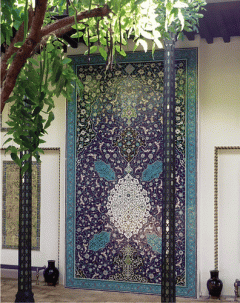
Figure 1. Mosaic tile panel on view in the central courtyard of Shangri La, Honolulu. Commissioned by Doris Duke and James Cromwell from a workshop in Isfahan, Iran in 1938. Glazed stonepaste, 240 x 132 in. (609.6 x 335.3 cm). DDFIA 48.93. Photograph by the author, 2011.
